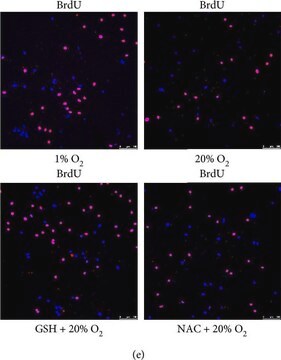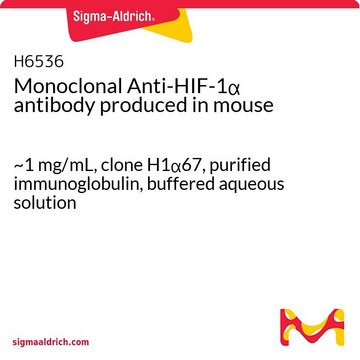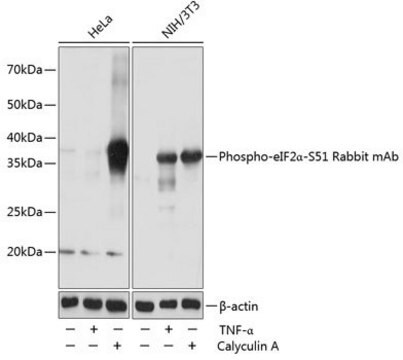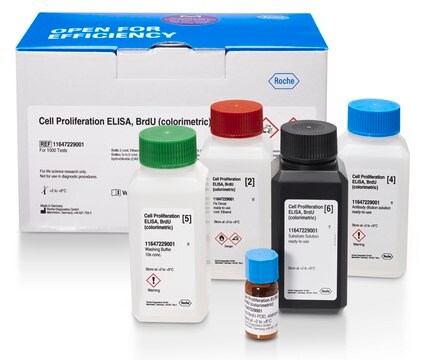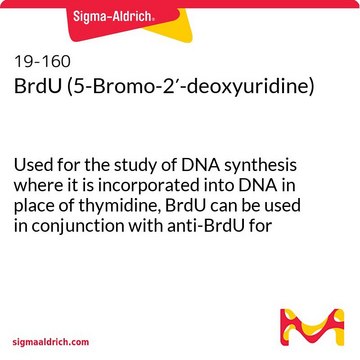SAB4700630
Monoclonal Anti-5-bromodeoxyuridine antibody produced in mouse
clone MoBu-1, purified immunoglobulin, buffered aqueous solution
Sinônimo(s):
Anti-BrdU
Faça loginpara ver os preços organizacionais e de contrato
About This Item
Código UNSPSC:
12352203
NACRES:
NA.41
Produtos recomendados
fonte biológica
mouse
Nível de qualidade
conjugado
unconjugated
forma do anticorpo
purified immunoglobulin
tipo de produto de anticorpo
primary antibodies
clone
MoBu-1, monoclonal
Formulário
buffered aqueous solution
concentração
1 mg/mL
técnica(s)
flow cytometry: suitable
Isotipo
IgG1
Condições de expedição
wet ice
temperatura de armazenamento
2-8°C
modificação pós-traducional do alvo
unmodified
Categorias relacionadas
Descrição geral
The antibody MoBu-1 reacts specifically with BrdU incorporated into DNA during S-phase of a cell cycle. The antibody MoBu-1 is also useful for detecting proliferating cells by flow cytometry or immunofluorescence staining. It reacts also specifically with 5-bromouridine (BrU).
Imunogênio
5-bromodeoxyuridine conjugated with hemocyanine
Aplicação
Monoclonal Anti-5-bromodeoxyuridine antibody produced in mouse has been used in Immunocytochemistry. The reagent is designed for Flow Cytometry analysis. Suggested working dilution for Flow Cytometry is 1-2 μg/mL of sample. Indicated dilution is recommended starting point for use of this product. Working concentrations should be determined by the investigator.
Ações bioquímicas/fisiológicas
5-Bromodeoxyuridine (BrdU) is an analogue of thymidine, used to measure DNA synthesis immunochemically in living cells. BrdU along with cAMP and butyrate plays a vital role in the cellular differentiation in several mammalian cell types. It also inhibits cell growth in mammalian and yeast cells by modulating the expression of particular genes involved in cell division. In the absence of DNA synthesis, brdu promotes mouse neuroblastoma C1300 cell differentiation into cells that morphologically are similar to mature neurons. BrdU activates cell senescence-like phenomenon in mammalian cells.
Características e benefícios
Evaluate our antibodies with complete peace of mind. If the antibody does not perform in your application, we will issue a full credit or replacement antibody. Learn more.
forma física
Solution in phosphate buffered saline, pH 7.4, with 15 mM sodium azide.
Exoneração de responsabilidade
Unless otherwise stated in our catalog or other company documentation accompanying the product(s), our products are intended for research use only and are not to be used for any other purpose, which includes but is not limited to, unauthorized commercial uses, in vitro diagnostic uses, ex vivo or in vivo therapeutic uses or any type of consumption or application to humans or animals.
Não está encontrando o produto certo?
Experimente o nosso Ferramenta de seleção de produtos.
Código de classe de armazenamento
10 - Combustible liquids
Ponto de fulgor (°F)
Not applicable
Ponto de fulgor (°C)
Not applicable
Escolha uma das versões mais recentes:
Já possui este produto?
Encontre a documentação dos produtos que você adquiriu recentemente na biblioteca de documentos.
Os clientes também visualizaram
D Stanek et al.
European journal of cell biology, 79(3), 202-207 (2000-04-25)
The available data concerning the subnucleolar localisation of the individual steps of precursor-ribosomal RNA (pre-rRNA) processing are ambiguous. According to in situ hybridisation studies, the late steps of pre-rRNA processing have been located into the granular component of the nucleolus
Alessio Ligabue et al.
PloS one, 7(10), e47318-e47318 (2012-10-12)
5-fluorouracil, a commonly used chemotherapeutic agent, up-regulates expression of human thymidylate synthase (hTS). Several different regulatory mechanisms have been proposed to mediate this up-regulation in distinct cell lines, but their specific contributions in a single cell line have not been
Overexpression of HAM1 gene detoxifies 5-bromodeoxyuridine in the yeast Saccharomyces cerevisiae.
Takayama S, et al.
Current Genetics, 52(5-6), 203-211 (2007)
AT-hook proteins stimulate induction of senescence markers triggered by 5-bromodeoxyuridine in mammalian cells.
Satou W, et al.
Experimental Gerontology, 39(2), 173-179 (2004)
5-bromodeoxyuridine-induced differentiation of a neuroblastoma.
Schubert D and Jacob F.
Proceedings of the National Academy of Sciences of the USA, 67(1), 247-254 (1970)
Global Trade Item Number
| SKU | GTIN |
|---|---|
| SAB4700630-100UG | 4061833632000 |
Nossa equipe de cientistas tem experiência em todas as áreas de pesquisa, incluindo Life Sciences, ciência de materiais, síntese química, cromatografia, química analítica e muitas outras.
Entre em contato com a assistência técnica

